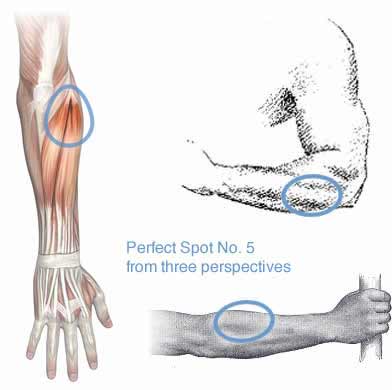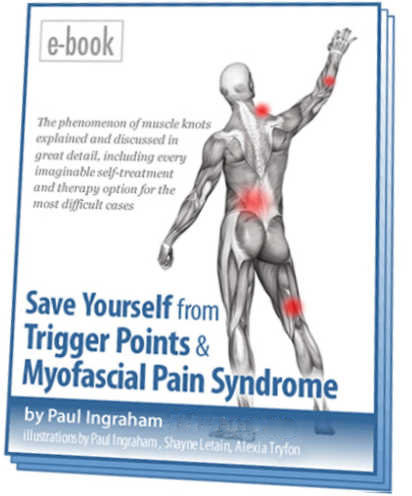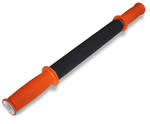Massage Therapy for Tennis Elbow and Wrist Pain
Perfect Spot No. 5, in the common extensor tendon of the forearm
Trigger points (TrPs), or muscle “knots,” are a common cause of stubborn & strange aches & pains, and yet they are under-diagnosed. The 14 Perfect Spots (jump to list below) are trigger points that are common & yet fairly easy to self-treat with massage — the most satisfying & useful places to apply pressure to muscle. For tough cases, see the advanced trigger point therapy guide.
Just beyond your elbow, all the muscles on the back of your forearm converge into a single thick tendon, the common extensor tendon. At the point where the muscles converge, in the muscles that extend the wrist and fingers, lies one of the more inevitable trigger points in the body: Perfect Spot No. 5. It is constantly provoked both by computer usage today, and more often by the use of a pen in simpler times — and by the occasional tennis match, then and now, or maybe crocheting.
Unlike trigger points in the back or the shoulders, where feelings of aching and stiffness are all-too-familiar, people are often unaware that there is anything wrong in their forearm until things get ugly. Unfortunately, instead of being diagnosed correctly, many people who develop an active Spot No. 5 are diagnosed with a tendinitis of the elbow (tennis elbow) or nerve impingement at the wrist (carpal tunnel syndrome)
Spot No. 5’s dramatic tennis elbow connection
Perfect Spot No. 5 is probably a major cause of or contributor to “tennis elbow,” technically known as lateral epicondylitis,1 which commonly afflicts typists as well as racquet sports players (and there are a lot more typists). Tennis elbow is regarded by most health care professionals as being a tendinitis2 of the common extensor tendon at the elbow — immediately to the “North” of Perfect Spot No. 5.
Instead, tennis elbow may be entirely the result of either the pain of TrPs themselves, or due to the fact that muscle knots are placing extra stress on the tendon (mechanical or biological). Regardless, the quickest path to relief in many cases is to massage Perfect Spot No. 5. Self-treating them is a low-cost, low-risk method. For more information, see the tennis elbow tutorial.

Tennis, meet elbow
Tennis is the traditional way to get a case of tennis elbow, but it is not actually the most common. Keyboard usage is undoubtedly by far the more common cause of the condition these days.
The strange relationship between Perfect Spot No. 5, wrist pain, and carpal tunnel syndrome
Surprisingly, a lot of wrist pain is either caused or complicated by myofascial TrPs in the forearm musculature, especially the extensors of the wrist and fingers, of which Perfect Spot No. 5 is the most common. This is mainly due to the phenomenon of “referred pain,” in which trouble in one spot is actually felt somewhere else. Sore forearm muscles, weirdly, often feel like wrist pain.3
The “cause or complicate” rule applies even with injuries: if you damage your wrist, muscle pain in the forearm is probably going to be a factor in recovery, and often accounts for stubborn symptoms long after the injury is otherwise healed.4
Carpal tunnel syndrome is one of those conditions with such a grandiose reputation, such over-the-top “popularity,” that it is usually suspected and diagnosed no matter how wrong the symptoms are.
Even when Spot 5 is not the actual cause of wrist pain, it is often such a significant complication that relieving it will come close to solving the problem. In fact, even in cases of actual carpal tunnel syndrome, where all the signs and symptoms really do fit with a diagnosis of carpal tunnel syndrome, treating trigger points in the forearm often seems to resolve the problem.5
And a (strange) scalene muscle connection with Spot No. 5 and tennis elbow
Curiously, a muscle in the neck seems to have an unusually strong effect on Perfect Spot No. 5. Travell and Simons write, “Scalene muscle trigger points are frequently the key to [treatment of] forearm extensor digitorum trigger points.”6 If you need to help your forearm muscles, I recommend also treating your scalene muscles — see Massage Therapy for Neck Pain, Chest Pain, Arm Pain, and Upper Back Pain.
How to find and treat Perfect Spot No. 5
The muscles on the back of your forearm lift your fingers and wrist. You can see them moving under the skin of your arm if you drum your fingers on a desk. In writing, typing, and mousing, these muscles must hold the wrist up and stable, and the fingers work constantly. In racquet sports, the forearm muscles particularly suffer because of the eccentric contraction required to stabilize the wrist on striking.7
Spot 5 is easy to find and treat yourself. Simply find the bony knob on the outside edge of your elbow. This is the point on which all the muscles on the back of your arm converge. Just beyond that point — below it, towards the wrist — you can easily find the thick bundle of tissue that is the “common extensor tendon.” Perfect Spot No. 5 is just a little further down, as the tendon turns into muscle.
Here’s another way of visualizing the location: imagine a wrist watch that you’re wearing really high on your arm ... almost at your elbow, but not quite. About an inch or two away. Perfect spot #5 is about where the face of the watch would be if you were wearing a watch that high on the arm.
Perfect Spot No. 5 is one of those Perfect Spots that is not alone in the area. You can find significant TrPs nearly anywhere in the muscles on the back of the forearm! Perfect Spot No. 5 is simply the best of the lot.
An easy way to self-treat this spot is to press it into a hard surface — the rounded edge of a counter top is about the right height and shape. It won’t take much experimentation for you to figure out exactly where to press! As always, go slow and easy at first to avoid aggravating it.

The Tiger Tail Rolling Muscle Massager: a particularly ideal massage tool for this spot
The Tiger Tail Rolling Muscle Massager (made by Polar Fusion, in Washington state) is terrific for self-massage of the arms and legs, and I’ve used it mostly for my shins. And then I learned that I’ve been missing an “obvious” and lovely way of using it to massage the forearms as well: just brace one end on the hip, hold the other with one hand, and then move the other arm across the roller. Suddenly it’s my new best friend! My forearms are chronically exhausted by long days of typing.
It is really just a specialized rolling pin, made for squishing muscle instead of dough. There is no question that I thought of (and tried) using an actual rolling pin for self-massage long, long before I’d heard of the Tiger Tail. But a rolling pin tends to be too hard, too broad, and too fragile (the handles tend not to be sturdy enough, unless you’ve got a really good quality rolling pin) for most massage purposes. The Tiger Tail solves these issues: it’s got a foam cover on a narrow cylinder, and it’s extremely sturdy.
This product is a perfect case study in how the right tool can make all the difference: I can self-massage my own arms with this tool effortlessly compared to trying to do the job with hands or any other tool. It’s easy to apply and control plenty of pressure.
About Paul Ingraham

I am a science writer in Vancouver, Canada. I was a Registered Massage Therapist for a decade and the assistant editor of ScienceBasedMedicine.org for several years. I’ve had many injuries as a runner and ultimate player, and I’ve been a chronic pain patient myself since 2015. Full bio. See you on Facebook or Twitter., or subscribe:
Appendix A: Is trigger point therapy too good to be true?
Trigger point therapy isn’t too good to be true: it’s just ordinary good. It can probably relieve some pain cheaply and safely in many cases. Good bang for buck, and little risk. In the world of pain treatments, that’s a good mix.
But pain is difficult and complex, no treatment is perfect, and there is legitimate controversy about the science of trigger points. Their nature remains somewhat puzzling, and the classic image of a tightly “contracted patch” of muscle tissue may well be wrong. What we do know is that people hurt, and it can often be helped.
The Perfect Spots are based on a decade of my own clinical experience as a massage therapist, and years of extensive science journalism on the topic. Want to know more? This is the tip of the iceberg. I’ve written a whole book about it …

Not too good to be true.
Just ordinary good. Trigger point therapy isn’t a miracle cure, but it is a valuable life skill. Practically anyone can benefit at least a little, and many will experience significant relief from stubborn aches and pains. The first few sections are free.
Appendix B: Quick Reference Guide to the Perfect Spots
This index is also available on its own page.
1For headache, neck pain
Under the back of the skull must be the single most pleasing and popular target for massage in the human body. No other patch of muscle gets such rave reviews. It has everything: deeply relaxing and satisfying sensations, and a dramatic therapeutic relevance to one of the most common of all human pains, the common tension headache. And no wonder: without these muscles, your head would fall off. They feel just as important as they are. (Click/tap heading to read more.)
| for pain: almost anywhere in the head, face and neck, but especially the side of the head, behind the ear, the temples and forehead | muscle(s): suboccipital muscles (recti capitis posteriores major and minor, obliqui inferior and superior) |
2For low back pain
This Perfect Spot lives in the “thoracolumbar corner,” a nook between your lowest rib and your spine — right where the stability of the rib cage and thoracic vertebrae gives way to the relative instability of the lumbar spine. It consists of trigger points in the upper-central corner of the quadratus (square) lumborum muscle and in the thick column of muscle that braces the spine, the erector spinae. (Click/tap heading to read more.)
| for pain: anywhere in the low back, tailbone, lower buttock, abdomen, groin, side of the hip | muscle(s): quadratus lumborum, erector spinae |
3For shin splints
Perfect Spot No. 3 is in your shins — seemingly an unlikely place for muscle knots! But there is meat there, and if you’ve ever had shin splints then you know just how vulnerable that meat can be. Even if you’ve never suffered so painfully, your shins probably still suffer in silence — latent trigger points in the upper third of the shin that don’t cause symptoms, but are plenty sensitive if you press on them. (Click/tap heading to read more.)
| for pain: in the shin, top of the foot, and the big toe | muscle(s): tibialis anterior |
4For thoracic outlet syndrome, throat pain and tightness, chest pain
Deep within the Anatomical Bermuda Triangle, a triangular region on the side of the neck, is the cantankerous scalene muscle group. Massage therapists have vanished while working in this mysterious area, never to be seen again. The region and its muscles are complex and peculiar, and many lesser-trained massage therapists have low confidence working with them. (Click/tap heading to read more.)
| for pain: in the upper back (especially inner edge of the shoulder blade), neck, side of the face, upper chest, shoulder, arm, hand | muscle(s): scalenes (anterior, middle, posterior) |
5For carpal tunnel syndrome, tennis elbow
Just beyond your elbow, all the muscles on the back of your forearm converge into a single thick tendon, the common extensor tendon. At the point where the muscles converge, in the muscles that extend the wrist and fingers, lies one of the more inevitable trigger points in the body: Perfect Spot No. 5. It is constantly provoked both by computer usage today, and more often by the use of a pen in simpler times — and by the occasional tennis match, then and now, or maybe crocheting. (Click/tap heading to read more.)
| for pain: in the elbow, arm, wrist, and hand | muscle(s): extensor muscles of the forearm, mobile wad (brachioradialis, extensor carpi radialis longus and brevis), extensor digitorum, extensor carpi ulnaris |
6For gluteal and hip pain, sciatica, bursitis, low back pain
When you have back pain, buttock pain, hip pain, or leg pain, much or even all of your trouble may well be caused by trigger points in the obscure gluteus medius and minimus muscles, a pair of pizza-slice shaped muscles a little forward of your hip pocket. Other muscles in the region are usually involved as well, such as the gluteus maximus, piriformis, and the lumbar paraspinal muscles. However, the gluteus medius and minimus are a bit special: their contribution to pain in this area is particularly significant, and yet people who have buttock and leg pain rarely suspect that much of it is coming from muscle knots so high and far out on the side of the hip. (Click/tap heading to read more.)
| for pain: in the low back, hip, buttocks (especially immediately under the buttocks), side of the thigh, hamstrings | muscle(s): gluteus medius and minimus |
7For jaw pain, bruxism, headache
Your masseter muscle is your primary chewing muscle — not the only one, but the main one — and it covers the sides of the jaw just behind the cheeks. It’s also the main muscle that clenches your jaw and grinds your teeth, unfortunately, and it’s one of the most common locations for trigger points in the human body. It is probably an accomplice in most cases of bruxism (that’s Latin for “grinding your teeth”) and temporomandibular joint syndrome (jaw joint pain), plus other unexplained painful problems in the area. (Click/tap heading to read more.)
| for pain: in the side of the face, jaw, teeth (rarely) | muscle(s): masseter |
8For runner’s knee
A lot of quadriceps aching, stiffness and fatigue emanates from an epicentre of “knotted” muscle in the lower third of the thigh, in the vastus lateralis, a huge muscle — one of your biggest — that dominates the lateral part of the leg. Stretching it is effectively impossible, but massage is an option: although often shockingly sensitive, Perfect Spot No. 8 can also be quite satisfying. It also often complicates or contributes to other problems in the area, especially runner’s knee (iliotibial band syndrome). (Click/tap heading to read more.)
| for pain: in the lower half of the thigh, knee | muscle(s): quadriceps (vastus lateralis, vastus intermedius, vastus medialis, rectus femoris) |
9For chest pain & tightness
The “pecs” are popular: of 700+ muscles, the pectoralis major is one of just a dozen or so that most people can name and point to. It also harbours one of the most commonly-encountered and significant trigger points in the human body, and can produce pain much like a heart attack in both quality and intensity. (Click/tap heading to read more.)
| for pain: anywhere in the chest, upper arm | muscle(s): pectoralis major |
10For plantar fasciitis
The tenth of the Perfect Spots is one of the most popular of the lot, and right under your feet — literally. It lies in the center of the arch muscles of the foot. This is one of the Perfect Spots that everyone knows about. No massage is complete without a foot massage! (Click/tap heading to read more.)
| for pain: in the bottom of the foot | muscle(s): arch muscles |
11For upper back pain
This “spot” is too large to really be called a “spot” — it’s more of an area. The thick columns of muscle beside the spine are often littered with muscle knots from top to bottom. Nevertheless, there is one section of the group where massage is particularly appreciated: from the thick muscle at the base of the neck, down through the region between the shoulder blades, tapering off around their lower tips. There is no doubt that this part of a back massage feels even better than the rest — even the low back, despite its own quite perfect spots, cannot compete. (Click/tap heading to read more.)
| for pain: anywhere in the upper back, mainly between the shoulder blades | muscle(s): erector spinae muscle group |
12For low back and gluteal pain, sciatica
At the top of the buttocks lies a Perfect Spot for massage: a sneaky but trouble-making brute of a trigger point that commonly forms in the roots of the gluteus maximus muscle. It’s below the lowest part of the low back, but it often feels like low back pain. This is the kind of spot that the Perfect Spots series is all about: not only does it tend to produce a profound, sweet ache when massaged, but the extent of the pain that spreads out around it is almost always a surprise. It feels like a key to much more than expected. (Click/tap heading to read more.)
| for pain: in the lower back, buttocks, hip, hamstrings | muscle(s): gluteus maximus |
13For low back pain, sciatica
Some of the Perfect Spots are perfect because they are “surprising” — it’s delightful to find a place to massage that feels highly relevant your pain in an unexpected location. Others are perfect because they are exactly where you expect them to be — and what a relief it is to be able to treat them. Perfect Spot No. 13 is perhaps the ultimate, the quintessential example of a trigger point that is usually “right where I thought the problem was”: in the “pit” of the low back, at the bottom of the thick columns of back muscle beside the spine. (Click/tap heading to read more.)
| for pain: in the low back, buttocks, hamstrings | muscle(s): erector spinae muscle group at L5 |
14For shoulder pain
I avoided adding Spot 14 to this series for many years, because it’s a bit tricky to find. But precision is not required: although there is one specific spot that’s especially good, nearly anywhere under the ridge of bone on the shoulder blade is worthwhile, and often a surprising key to pain and stiffness everywhere else in the shoulder, especially all the way around on the other side, facing forward. (Click/tap heading to read more.)
| for pain: any part of the shoulder, and upper arm | muscle(s): infraspinatus, teres minor |
What’s new in this article?
2019 — Editing and modernization with miscellaneous science updates (e.g. regarding inflammation and tendinitis), and taming the claims about trigger points (excessive enthusiasm dating back to the 2000s still being dialed back).
2005 — Publication.
Notes
- The science is not in on this and may never be. It’s a reasonable theory, but hardly proven. The nature and clinical relevance of trigger points is controversial (see Trigger Points on Trial). Many clinicians have noted the link between lateral epicondylalgia and the presence of trigger points, including myself, for whatever that is worth (not much, really — there are a lot of ways to be wrong about this stuff).
“Tendinitis” versus “tendonitis”: Both spellings are acceptable these days, but the first is the more legitimate, while the second is just an old misspelling that has become acceptable only through popular use, which is a thing that happens in English. The word is based on the Latin “tendo” which has a genitive singular form of tendinis, and a combining form that is therefore tendin. (Source: Stedmans Electronic Medical Dictionary.)
“Tendinitis” vs “tendinopathy”: Both are acceptable labels for ticked off tendons. Tendinopathy (and tendinosis) are often used to avoid the implication of inflammation that is baked into the term tendinitis, because the condition involves no signs of gross, acute inflammation. However, recent research has shown that inflammation is actually there, it’s just not obvious. So tendinitis remains a fair label, and much more familiar to patients to boot.
- The brain is somewhat inept at precisely locating internal pain and so sometimes we experience pain in a broad area around or near the cause, or even further afield. This is the same phenomenon as heart attack pain felt mainly in the arm: the brain just can’t figure out where the pain is coming from, and the arm pain is a bad “guess.” Patterns of referral from the musculoskeletal system are somewhat predictable, and most referred pain spreads away from the centre and the head (laterally, distally). By contrast, visceral referral is much more erratic.
- Ingraham. Muscle Pain as an Injury Complication: The story of how I finally “miraculously” recovered from the pain of a serious shoulder injury, long after the injury itself had healed. PainScience.com. 4408 words.
- Perhaps trigger points actually directly contribute to the pathology of carpal tunnel syndrome. For instance, it’s possible that the referred pain of trigger points sensitizes the median nerve, making it more vulnerable to compression in the carpal tunnel. Rather than relieving abnormal pressure on a healthy nerve, treating the trigger points in the forearm reduces the nerve’s abnormal sensitivity — problem solved either way.
- Travell J, Simons D, Simons L. Myofascial Pain and Dysfunction: The Trigger Point Manual. 2nd ed. Lippincott, Williams & Wilkins; 1999. Volume 1, p513.
- An eccentric contraction is an interesting type of muscular contraction while lengthening — an apparent contradiction! Eccentric contraction is a bit mysterious, and is known to be a bit “harder” on muscle and a strong stimulus to adaptation.
The momentum of the racquet is considerable with every strike. The forearm extensors must contract eccentrically to slow the racquet down. If they didn’t, the wrist would snap forward (flex) violently, out of control. So the muscles on the back of the forearm are contracting to slow down and control wrist flexion.

